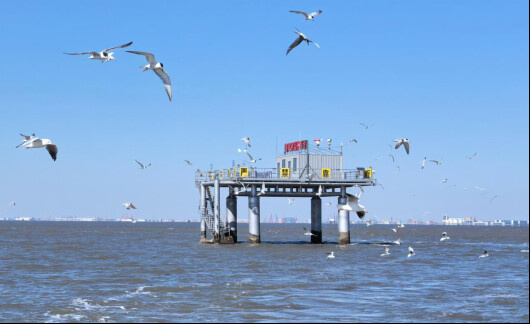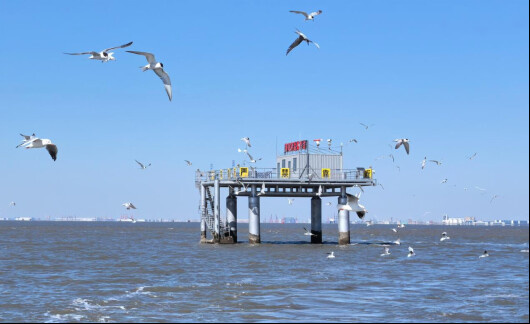By Shi Ziqiang, People's Daily

Photo shows a smart offshore seagrass bed monitoring platform in Caofeidian, Hebei province. (Photo courtesy of the Department of Natural Resources of Hebei Province)
Off the coast of Tangshan in north China's Hebei province, a quiet ecological transformation unfolds beneath the waves of Bohai Bay. Vibrant green expanses are emerging in these coastal waters - fields of seagrass forming "underwater meadows."
Once degraded, these vital ecosystems are now being carefully restored through a long-term, systematic effort. Among them, the Caofeidian seagrass bed stands out as the largest continuous single-species seagrass habitat in China, spanning over 4,400 hectares.
In recent years, Hebei has advanced its efforts to protect and restore marine ecosystems, developing a comprehensive and multi-pronged restoration system for seagrass beds. As a result, vegetation coverage has steadily increased, and the ecological benefits are becoming increasingly evident.
A 30-minute speedboat ride southeast from the central fishing port of Caofeidian brings visitors to a smart offshore monitoring platform. Nearby lies the site of the phase-1 Caofeidian seagrass bed restoration project.
As the tide recedes, the underwater meadow reveals itself. In the shallows, lush green seagrass sways with the waves. This species of eelgrass can grow from several dozen centimeters to over one meter in length and makes up the primary vegetation of the Caofeidian seagrass bed.
Seagrass beds play a crucial role in the marine ecosystem: they stabilize the seabed, prevent sediment erosion, and provide critical habitat for a wide range of marine organisms, thereby supporting biodiversity.
A few years ago, however, the Caofeidian seagrass bed began to show signs of degradation, with some areas becoming sparse or barren. "Frequent fishing activities such as trawling and clam digging damage the seagrass and ecological environment, squeezing out living space and disrupting benthic communities and the broader ecosystem," explained Shi Zhijun, deputy director of the Caofeidian natural resources and planning bureau.
To reverse this decline, Hebei launched the Caofeidian seagrass bed restoration project in 2019. Measures included clearing abandoned fishing nets and traps, restricting vessel access in restoration zones to minimize disturbance, and improving nearshore water quality. Tangshan also explored technical standards for monitoring wastewater outlets and remediated 283 discharge points in the bay.
Aerial images taken before and after the restoration clearly show that sparse and barren patches are now flourishing with seagrass. "These new growths were all planted by hand," said Niu Shihao, a senior engineer with the Hebei Hydrogeology and Engineering Geology Exploration Institute.
Successful underwater planting requires precise tidal coordination. "It's all about knowing the tides - you only get a window of two to three hours each time," explained Niu. Crews must reach the site about two hours before low tide to prepare, distributing crates of seagrass to designated spots to save time. Once the tide reaches the optimal level, transplanting begins immediately.
"Initial attempts failed when currents displaced seedlings within days," noted Shi. "We discovered anchoring roots with compact mud blocks ensures plant stability."
Complementing transplantation, technicians developed a seed-ball method. He Rongda, a villager from Liuzan township who took part in the project, described the process: "Guided by technical staff, we mixed soil to mimic marine sediment, rolled it into ping pong-sized balls, embedded the seeds inside, and used a seeding device to bury them in the seabed. This way, the seeds could sprout without being washed away."
The project also adopted a differentiated restoration strategy. In areas with strong natural recovery potential, passive restoration combined with routine patrols was sufficient. In more severely degraded zones, more intensive interventions were applied, including sediment remediation, direct seeding, transplanting seedlings, and relocating mature plants.
With growing experience and improved techniques, the restoration of Caofeidian's seagrass has become more efficient and science-based. The once-degraded ecosystem is gradually returning to life.
After six years of sustained effort, the project has yielded promising results. "Systematic ecological restoration has led to continuous recovery of the seagrass beds, which now serve as vital habitats, migration corridors, and breeding grounds for marine life. The number of large benthic species has increased from 60 to 111, and the biodiversity index has risen by 42.3% year on year," said Wen Guoyi, an official with the Ministry of Natural Resources.
Once degraded, these vital ecosystems are now being carefully restored through a long-term, systematic effort. Among them, the Caofeidian seagrass bed stands out as the largest continuous single-species seagrass habitat in China, spanning over 4,400 hectares.
In recent years, Hebei has advanced its efforts to protect and restore marine ecosystems, developing a comprehensive and multi-pronged restoration system for seagrass beds. As a result, vegetation coverage has steadily increased, and the ecological benefits are becoming increasingly evident.
A 30-minute speedboat ride southeast from the central fishing port of Caofeidian brings visitors to a smart offshore monitoring platform. Nearby lies the site of the phase-1 Caofeidian seagrass bed restoration project.
As the tide recedes, the underwater meadow reveals itself. In the shallows, lush green seagrass sways with the waves. This species of eelgrass can grow from several dozen centimeters to over one meter in length and makes up the primary vegetation of the Caofeidian seagrass bed.
Seagrass beds play a crucial role in the marine ecosystem: they stabilize the seabed, prevent sediment erosion, and provide critical habitat for a wide range of marine organisms, thereby supporting biodiversity.
A few years ago, however, the Caofeidian seagrass bed began to show signs of degradation, with some areas becoming sparse or barren. "Frequent fishing activities such as trawling and clam digging damage the seagrass and ecological environment, squeezing out living space and disrupting benthic communities and the broader ecosystem," explained Shi Zhijun, deputy director of the Caofeidian natural resources and planning bureau.
To reverse this decline, Hebei launched the Caofeidian seagrass bed restoration project in 2019. Measures included clearing abandoned fishing nets and traps, restricting vessel access in restoration zones to minimize disturbance, and improving nearshore water quality. Tangshan also explored technical standards for monitoring wastewater outlets and remediated 283 discharge points in the bay.
Aerial images taken before and after the restoration clearly show that sparse and barren patches are now flourishing with seagrass. "These new growths were all planted by hand," said Niu Shihao, a senior engineer with the Hebei Hydrogeology and Engineering Geology Exploration Institute.
Successful underwater planting requires precise tidal coordination. "It's all about knowing the tides - you only get a window of two to three hours each time," explained Niu. Crews must reach the site about two hours before low tide to prepare, distributing crates of seagrass to designated spots to save time. Once the tide reaches the optimal level, transplanting begins immediately.
"Initial attempts failed when currents displaced seedlings within days," noted Shi. "We discovered anchoring roots with compact mud blocks ensures plant stability."
Complementing transplantation, technicians developed a seed-ball method. He Rongda, a villager from Liuzan township who took part in the project, described the process: "Guided by technical staff, we mixed soil to mimic marine sediment, rolled it into ping pong-sized balls, embedded the seeds inside, and used a seeding device to bury them in the seabed. This way, the seeds could sprout without being washed away."
The project also adopted a differentiated restoration strategy. In areas with strong natural recovery potential, passive restoration combined with routine patrols was sufficient. In more severely degraded zones, more intensive interventions were applied, including sediment remediation, direct seeding, transplanting seedlings, and relocating mature plants.
With growing experience and improved techniques, the restoration of Caofeidian's seagrass has become more efficient and science-based. The once-degraded ecosystem is gradually returning to life.
After six years of sustained effort, the project has yielded promising results. "Systematic ecological restoration has led to continuous recovery of the seagrass beds, which now serve as vital habitats, migration corridors, and breeding grounds for marine life. The number of large benthic species has increased from 60 to 111, and the biodiversity index has risen by 42.3% year on year," said Wen Guoyi, an official with the Ministry of Natural Resources.
 Menu
Menu
 Coastal city in N China restores marine ecology with underwater seagrass meadows
Coastal city in N China restores marine ecology with underwater seagrass meadows
















